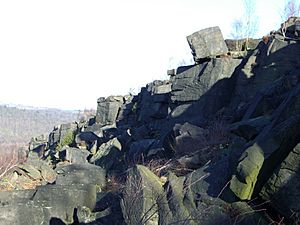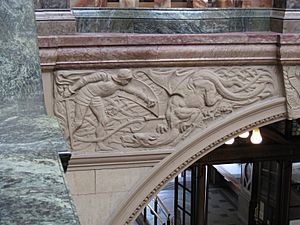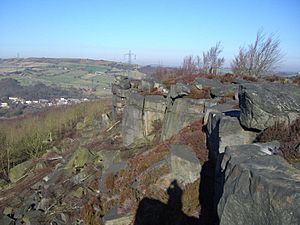Wharncliffe Crags facts for kids
Wharncliffe Crags is a huge, steep rock face made of gritstone. It's located about 10 kilometers (6 miles) northwest of Sheffield in South Yorkshire, England. This special area is important for its geology and is a Site of Special Scientific Interest.
Contents
Exploring Wharncliffe Crags
This long, steep cliff stretches for about 4 kilometers (2.5 miles). It starts near the village of Deepcar and goes southeast towards Wharncliffe Side. Wharncliffe Crags sits on the eastern side of the River Don valley, rising to about 250 meters (820 feet) above sea level. The highest point is 297 meters (974 feet) high.
Even though it's a beautiful natural spot, the northern part of the crags is quite close to busy roads like the Stocksbridge bypass. You can also see two lines of electricity pylons that meet at the northern end. The rocks here are incredibly old, formed 320 million years ago!
A Look Back in Time
People have used the rocks at Wharncliffe Crags for a very long time. As far back as the Iron Age and during the Roman times, people quarried stones here to make quern-stones. These were hand mills used to grind grain. In fact, the name Wharncliffe comes from "quern cliff"!
You can still see many signs of this old work, like flat areas where people worked and paths they used. Many unfinished quern-stones were left behind. In 1996, a heather fire accidentally burned away plants, showing even more hidden quern-stones. A survey in 2000 found about 2,300 stones in one small area, suggesting there could be around 8,000 in total! This area is now a protected historical site.
At the southern end of the crags is Wharncliffe Lodge, a building from the 1800s. It's the third lodge built on this spot, with the first one dating back to 1510. A famous person, Lady Mary Wortley Montagu, stayed here in the early 1700s. One room even has a mark from the time of Henry VIII (1509–1547).
Rocks, Trees, and Animals
Wharncliffe Crags was named a Site of Special Scientific Interest in 1988 because of its unique geology. The cliff face shows a great example of the Wharncliffe Edge Rock Formation. You can see two main sandstone layers that were once laid down as mud and sand by a winding river millions of years ago.
Below the cliffs, towards the Don valley, you'll find Wharncliffe Woods. These woods are full of birch and oak trees and are managed by the Forestry Commission. On top of the crags, the flat ground is mostly covered in heather.
The open land behind the middle part of the crags is called Wharncliffe Chase. Long ago, in the Middle Ages, this was a royal hunting park. More recently, people mined a material called ganister here, which was used to make bricks for steel furnaces. There was also some small-scale coal mining in the past.
Wharncliffe Heath Local Nature Reserve
The northwestern part of the crags, near Deepcar, is part of the Wharncliffe Heath Local Nature Reserve. This area has heather, bracken, and woodland, providing a home for many different animals and plants.
You might spot rare creatures like the nightjar (a bird), linnet, viviparous lizard, and the shiny green tiger beetle. This reserve is one of the best examples of dry heathland in the Sheffield area. It's different from the nearby Peak District moorlands because it's a mix of heather, bushes, and bracken. The Wharncliffe Heathlands Trust looks after the reserve, working to keep the birch bushes from taking over and creating more open areas.
Rock Climbing Adventures
Wharncliffe Crags has a long and exciting history of rock climbing. It was one of the first places in the UK where the sport began in the 1880s! A famous climber named J. W. Puttrell visited the crags often from 1885 and created many early climbing routes. His most famous was "Puttrell's Progress," first climbed around 1900.
By 1900, Wharncliffe Crags was the most popular climbing spot in the country. This was partly because Deepcar railway station was nearby, making it easy to reach. Over time, other places in the Peak District became more popular, and now Wharncliffe Crags is a quieter climbing spot. There are about 142 traditional climbs here, plus many bouldering routes on the large rocks that have broken off the main cliff.
The Dragon's Tale
The crags are also famous for the legend of the Dragon of Wantley. This old myth was turned into a poem and an opera in the 1600s. Even Sir Walter Scott mentioned it in his famous book Ivanhoe.
The story tells of a brave man named More, from More Hall, who defeats a troublesome dragon living on the crags. There's even a real cave at the southern end of the crags, near Wharncliffe Lodge, called the "Dragon's Den." You can find it marked on maps!
Images for kids











